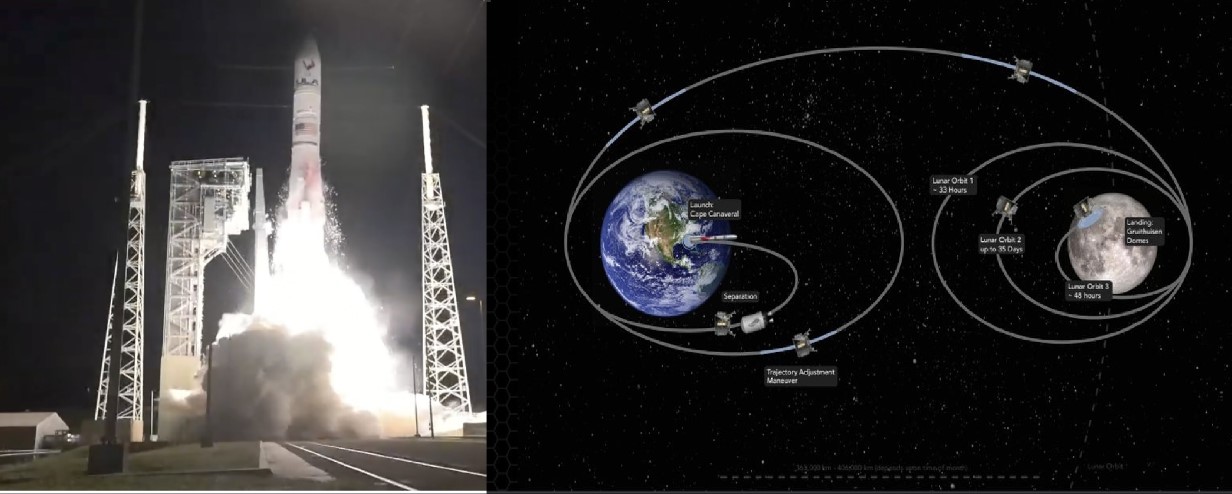ULA Vulcan Rocket Launches Private US Moon Lander, 1st Since Apollo, And Human Remains in Debut Flight

Space News ,World :- In
the early hours of January 8, the United Launch Alliance (ULA) Vulcan
Centaur embarked on a historic journey, marking its inaugural flight
named Cert-1. Taking off from Cape Canaveral Space Force Station in
Florida, the 202-foot-tall rocket, fueled by two solid rocket boosters
and two Blue Origin-built BE-4 first-stage engines, roared into the dark
Florida sky with a staggering 2 million pounds of thrust.
Perched
atop the rocket was the Astrobotic Peregrine moon lander, hailing from
Pittsburgh, carrying a diverse payload of 20 items, including five NASA
science instruments. The spectacle was nothing short of breathtaking as
Vulcan exhaust formed a towering pillar, and two minutes post-launch,
the solid rocket boosters gracefully detached from the first-stage
booster.
Around five minutes later, the first stage shut its
engines down, initiating the separation from the Centaur upper stage.
After a 15-second coast phase, Centaur executed the first of three
burns, marking a significant phase in the mission. Approximately 50.5
minutes post-launch, Peregrine was released to commence its lunar
voyage.
Amidst the excitement, ULA president and CEO Tory Bruno
exclaimed, "Yeehaw! I am so thrilled, I can not tell you how much." This
mission could potentially make history, with Peregrine becoming the
first American spacecraft to touch the moon surface since Apollo 17 in
1972 and, perhaps, the first private mission ever to land on the moon.
The
Cert-1 launch is a key milestone for NASA Commercial Lunar Payload
Services (CLPS) initiative. Astrobotic Peregrine, contracted through
CLPS, not only marks a significant achievement for the space agency but
also sets the stage for a new era of lunar exploration.
NASA CLPS
contracts, exemplified by Peregrine mission, are transforming the way
space missions are executed. Instead of handling every aspect
internally, NASA is now collaborating with private companies, like
Astrobotic, to handle mission design, lander construction, launch
vehicle procurement, and communication systems. This shift allows NASA
to focus on cutting-edge research and development, preparing for the
Artemis program ambitious goal of landing astronauts on the moon by 2025
or 2026.
The Peregrine mission carries five scientific payloads
from NASA, designed to study various aspects of the lunar environment.
These instruments will play a crucial role in preparing for future
Artemis missions, particularly those targeting the moon southern polar
region, rich in water ice.
Astrobotic Peregrine is not only
advancing scientific exploration but also serving as a platform for
international cooperation. The 20-payload roster includes contributions
from six nations, marking a collaborative effort to explore and
understand the moon mysteries.
However, the mission is not
without its share of controversies. Celestis, a space memorial company,
has included a payload named Tranquility, carrying the DNA and cremated
remains of individuals to be permanently placed on the moon. This move
has sparked ethical debates and objections, notably from the Navajo
Nation. The incident underscores the challenges of balancing commercial
interests with ethical considerations in the evolving landscape of lunar
exploration.
As Peregrine heads towards its lunar landing
scheduled for February 23, the success of this mission will not only
make history but also pave the way for a new chapter in lunar
exploration, demonstrating the potential of collaboration between public
and private entities in shaping the future of space exploration.


